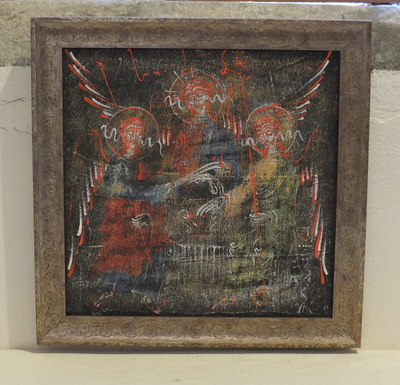
The icon was a gift from Bishop Malkhaz Songulashvili of the Georgian Baptist church (which is very similar to the Eastern European Orthodox churches) and blessed by him on Trinity Sunday 2010. The bishop had been studying in Oxford and used to visit Holy Trinity since he had an interest in C.S. Lewis. He offered to donate us an icon from his own tradition and we suggested one of the Trinity. This is a version of the classic Trinity icons based on the ‘Hospitality of Abraham’ in Genesis 18.
We are more familiar with the Rublev version of the Holy Trinity, on which our altar tapestry is based, which is 15th century and influenced by renaissance art. The version we have was written (icons are ‘written’ not painted as the artists see themselves as writing theology for us) in Georgia by an icon writer who is a friend of the bishop. However it is based on an icon writing tradition which precedes the Rublev version by several centuries. It seems to me much more mysterious and less forthright than the Rublev.
Tim Stead
Some members of the congregation spent a winter’s evening in contemplation in front of the Trinity icon. The experience inspired them to write the meditations below.
Doors to Paradise?
Instead of reaching out to an icon and, as it were, seizing its meaning, it is best to stand peacefully before it and let the meaning come to us. (Pitkin Guide to Icons)
The first time I sat before the icon, it was grey afternoon and I had decided to come and meditate quietly as a reaction to being over busy. What struck me was the flow between the figures, which also reach out to us, like a ceaseless cosmic blessing. It made me think about activity in a different sort of way – of being part of the dance, allowing it to flow through one rather than forcing one’s way against the current, so that one is not drawn out of one’s centre by what is happening.
Sitting in candlelit darkness was different. I saw the protectiveness of the angels’ wings and their extraordinary skeletal hands through which light flows – the light that permeates the icon, as if it is being creatively woven into everything. It was as if the things I was consciously holding in the light and what the icon revealed were at one and I was drawn into prayer and timeless silence.
Julia Cousins
…………….
Our icon does not reveal itself easily. The gaze of the three mysterious figures is not on us but on infinity. It is for us to see them.
Stillness sizzles with energy.
Mystery reaches out to touch and bless.
Three faces floating on the retina like an after-trace of light,
Eyes are veiled in contemplation, heads circled in fire.
The figures release pulsing embers of light,
curls of energy
that dance upward on the breath.
Three heads haloed with fire.
Three rods that are arrows of flame.
Wherever I look I sense God,
Like blood glowing under the skin.
Who can see the face of God?
I gaze, I refocus, the embers burn.
For a moment I see the spirit within the divine faces
Then they blur once more,
And the mystery deepens.
Jemima Kallas
………………..
This icon has a smoky ethereal quality. The image is not static but alive. It is strange, unformed and illusive, as if the artist is saying “I can’t paint God! I can only invite you to reflect on possibilities, to do with trinity, unity, energy, love …”
Waving white lines partially hide the three faces of the Trinity. No clear lines define their bodies against the background yet there they are, attentive to one another, opening to us, a hand directing the eye to the cup of suffering.
I have thought for a while now that of course God must be trinity, if God is love. For love cannot exist alone. Harry Williams (monk at Community of the Resurrection, Mirfield) said that people are frightened both of total isolation and of total absorption. We do not want to be alone, but we also do not want to be absorbed into the other. The trinity holds us perfectly in balance, in a union which neither absorbs nor alienates. We can be ourselves but we are not alone.
Susie Stead
………………
When I first sat before the icon in a darkness lit by candles, I felt alienated from it. The picture of the Holy Trinity is so familiar and loved in its more accessible versions, not least that of the tapestry above our altar, that this unfamiliar interpretation felt cold initially. What were those coils across the faces of the three figures? Why do there appear to be bolts of electricity behind and around them? Why are the hands so skeletal?
But as I sat there in the silence I began to feel quite differently. The picture drew me into itself; what had seemed alienating became comforting. The bolts of electricity are not white and cold, but hot and red. The three figures sit peacefully locked together in love but around them flows a current that is pulsing with heat and energy.
Stillness and energy in perfect combination. For me, time stood still as the Trinity held me in its mystery.
Anne Tarassenko
